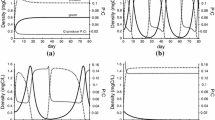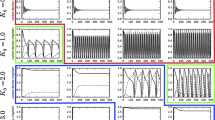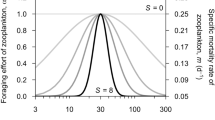Abstract
Phosphorus is an essential element for all life forms, and it is also a limiting nutrient in many aquatic ecosystems. To keep track of the mismatch between the grazer’s phosphorus requirement and producer phosphorus content, stoichiometric models have been developed to explicitly incorporate food quality and food quantity. Most stoichiometric models have suggested that the grazer dynamics heavily depends on the producer phosphorus content when the producer has insufficient nutrient content [low phosphorus (P):carbon (C) ratio]. However, recent laboratory experiments have shown that the grazer dynamics are also affected by excess producer nutrient content (extremely high P:C ratio). This phenomenon is known as the “stoichiometric knife edge.” While the Peace et al. (Bull Math Biol 76(9):2175–2197, 2014) model has captured this phenomenon, it does not explicitly track P loading of the aquatic environment. Here, we extend the Peace et al. (2014) model by mechanistically deriving and tracking P loading in order to investigate the growth response of the grazer to the producer of varying P:C ratios. We analyze the dynamics of the system such as boundedness and positivity of the solutions, existence and stability conditions of boundary equilibria. Bifurcation diagram and simulations show that our model behaves qualitatively similar to the Peace et al. (2014) model. The model shows that the fate of the grazer population can be very sensitive to P loading. Furthermore, the structure of our model can easily be extended to incorporate seasonal P loading.




Similar content being viewed by others
References
Andersen T (1997) Pelagic nutrient cycles: herbivores as sources and sinks. Springer, New York
Andersen T, Elser JJ, Hessen DO (2004) Stoichiometry and population dynamics. Ecol Lett 7(9):884–900
Berger SA, Diehl S, Kunz TJ, Albrecht D, Oucible AM, Ritzer S (2006) Light supply, plankton biomass, and seston stoichiometry in a gradient of lake mixing depths. Limnol Oceanogr 51(4):1898–1905
Boersma M, Elser JJ (2006) Too much of a good thing: on stoichiometrically balanced diets and maximal growth. Ecology 87(5):1325–1330
Diehl S (2007) Paradoxes of enrichment: effects of increased light versus nutrient supply on pelagic producer–grazer systems. Am Nat 169(6):E173–E191
Elser JJ, Hayakawa K, Urabe J (2001) Nutrient limitation reduces food quality for zooplankton: Daphnia response to seston phosphorus enrichment. Ecology 82(3):898–903
Elser JJ, Watts J, Schampel JH, Farmer J (2006) Early Cambrian food webs on a trophic knife-edge? A hypothesis and preliminary data from a modern stromatolite-based ecosystem. Ecol Lett 9(3):295–303
Elser JJ, Loladze I, Peace AL, Kuang Y (2012) Lotka re-loaded: modeling trophic interactions under stoichiometric constraints. Ecol Model. 245:3–11
Kot M, Sayler GS, Schultz TW (1992) Complex dynamics in a model microbial system. Bull Math Biol 54(4):619–648
Loladze I, Kuang Y, Elser J (2000) Stoichiometry in producer–grazer systems: linking energy flow with element cycling. Bull Math Biol 62:1137–1162
Matsumura T, Sakawa Y (1980) Non-linear analysis of nitrogen cycle in aquatic ecosystems. Int J Syst Sci 11(7):803–816
Moe SJ, Stelzer RS, Forman MR, Harpole WS, Daufresne T, Yoshida T (2005) Recent advances in ecological stoichiometry: insights for population and community ecology. Oikos 109(1):29–39
Peace A, Zhao Y, Loladze I, Elser JJ, Kuang Y (2013) A stoichiometric producer–grazer model incorporating the effects of excess food-nutrient content on consumer dynamics. Math Biosci 244(2):107–115
Peace A, Wang H, Kuang Y (2014) Dynamics of a producer–grazer model incorporating the effects of excess food nutrient content on grazers growth. Bull Math Biol 76(9):2175–2197
Sterner RW, Elser JJ (2002) Ecological stoichiometry: the biology of elements from molecules to the biosphere. Princeton University Press, Princeton
Urabe J, Sterner RW (1996) Regulation of herbivore growth by the balance of light and nutrients. Proc Natl Acad Sci 93(16):8465–8469
Wang H, Kuang Y, Loladze I (2008) Dynamics of a mechanistically derived stoichiometric producer–grazer model. J Biol Dyn 2(3):286–296
Yang XE, Wu X, Hao HL, He ZL (2008) Mechanisms and assessment of water eutrophication. J Zhejiang Univ Sci B 9(3):197–209
Author information
Authors and Affiliations
Corresponding author
Additional information
Publisher's Note
Springer Nature remains neutral with regard to jurisdictional claims in published maps and institutional affiliations.
Appendices
Appendix A. Proof of Theorem 3.1
Proof
We consider a solution \(S(t) \equiv (x(t), y(t), Q(t),P_f(t))\) of System (3) with initial condition in \(\Omega \). Hence, \(0< x(0), 0< y(0) , q< Q(0)< \hat{Q}, 0< P_f(0), Q(0) x(0)+\theta y(0)+ P_f(0) < P_{f_{\mathrm{in}}}\). Assume that there exists a time \(t_1 > 0\) such that S(t) touches or crosses a boundary of \(\bar{\Omega }\) (closure of \(\Omega \)) for the first time, and then \((x(t), y(t), Q(t),P_f(t))\in \Omega \) for \( 0 \le t<t_1\). We will have several cases to consider.
Case 1\(x(t_1) = 0\). Let \(\overline{f}=f'(0)=\lim _{x\rightarrow 0} \frac{f(x)}{x}\) and \(\overline{y}=\max _{t \in [0, t_1]} y(t) < \frac{P_{f_{\mathrm{in}}}}{\theta }\). Then for every \(t \in [0,t_1]\), we have
where \(\alpha _1\) is a constant. Then, \(x(t)\ge x(0)e^{\alpha _1 t} > 0\) for \(t \in [0, t_1]\), which implies that \(x(t_1)\ge x(0)e^{\alpha _1 t_1} > 0\), a contradiction. This proves that \(S(t_1)\) does not reach this boundary.
Case 2\(y(t_1) = 0\). Then, for every \(t \in [0, t_1]\), we have
where \(\alpha _2\) is a constant. This implies that \(y(t_1) \ge y(0)e^{\alpha _2 t_1} > 0\), a contradiction. This proves that \(S(t_1)\) does not reach this boundary.
Case 3\(Q(t_1)=q\). Then, for every \(t \in [0, t_1]\), we have
This implies that \(Q(t_1) \ge q + (Q(0) - q)e^{-bt_1} > q\), a contradiction. This proves that \(S(t_1)\) cannot cross this boundary.
Case 4\(Q(t_1) = \hat{Q}\). Since \(\upsilon (P_f(t_1),Q(t_1)) = 0\)
Thus, \(S(t_1)\) cannot cross this boundary.
Case 5\(P_f(t_1)=0\). Since \(\upsilon (P_f(t_1),Q(t_1)) = 0\) and \(\rho (P_{f_{\mathrm{in}}}-P_f(t_1))=\rho P_{f_{\mathrm{in}}} \)
Thus, \(S(t_1)\) cannot cross this boundary.
Case 6\( P_f(t_1)+Q(t_1)x(t_1)+\theta y(t_1)= P_{f_{\mathrm{in}}}\). Let \(z(t)=P_{f_{\mathrm{in}}}-P_f(t)-Q(t)x(t)-\theta y(t)\), then \(z(t_1)=0\) and \(z(t)>0\) for \(0 \le t < t_1\). Then for every \(t \in [0,t_1]\), we have
where \(\rho \) is a constant. This implies that \(z(t_1)= e^{-\rho t_1} z(0) > 0\), a contradiction. This proves that \(S(t_1)\) cannot cross this boundary. \(\square \)
Appendix B. Proof of Theorem 3.2
Proof
At \(E_0=(0,0,Q_0,P_{f_{\mathrm{in}}} )\), the Jacobian matrix is
where \(\frac{\mathrm{d} \upsilon }{ \mathrm{d}Q}\bigg |_{\begin{array}{c} E_0 \end{array}}-b=-\frac{\hat{c} P_{f_{\mathrm{in}}}}{ (\hat{a}+ P_{f_{\mathrm{in}}}) (\hat{Q} -q)}-b<0\). The eigenvalues of \(J(E_0)\) are \( b(1-\frac{q}{Q_0})-\rho \), \(-d-\rho \), \(\frac{\mathrm{d} \upsilon }{ \mathrm{d}Q}\bigg |_{\begin{array}{c} E_0 \end{array}}-b\), and \(-\rho \).
If \(b(1-\frac{q}{Q_0})>\rho \), then the distinct real eigenvalues are of opposite signs. So \(E_0\) is unstable in the form of a saddle. \(\square \)
Appendix C. Proof of Theorem 3.3
Proof
Assume that \(\min \left\{ \hat{e}f(x_1),\frac{Q_1}{\theta }f(x_1),\hat{e}\hat{f}\frac{\theta }{Q_1}\right\} < d+\rho \). To prove that \(E_1\) is locally asymptotically stable, we consider two cases ( \(1 - \frac{x}{K} < 1 -\frac{q}{Q}\) and \(1 - \frac{x}{K} > 1 -\frac{q}{Q}\)) where we look at the linearized system and use the Routh–Hurwitz criterion.
Case 1 \(1 - \frac{x}{K} < 1 -\frac{q}{Q}\)
Here, \(E_1=(x_1,0,Q_1,P_{f_1})= \Big (\frac{K(b-\rho )}{b},0,\frac{\hat{c}P_{f_1}\hat{Q}}{(\hat{a}+P_{f_1})(\hat{Q}-q) \rho +\hat{c}P_{f_1}},P_{f_1}\Big )\) by Sect. 3.2 and the Jacobian takes the following form:
where \(G(E_1)=\min \Bigg \{ \hat{e}f(x_1),\frac{Q_1}{\theta }f(x_1),\hat{e}\hat{f}\frac{\theta }{Q_1}\Bigg \} -d-\rho \).
Let \(\rho <b\), \(G(E_1)<0\), \(\alpha _1=\frac{\mathrm{d} \upsilon }{ \mathrm{d}Q}\bigg |_{\begin{array}{c} E_1 \end{array}}=-\frac{\hat{c} P_f}{ (\hat{a}+ P_f) (\hat{Q} -q)}\bigg |_{\begin{array}{c} E_1 \end{array}}<0\), and \(\alpha _2=\frac{\mathrm{d} \upsilon }{ \mathrm{d}P_f}\bigg |_{\begin{array}{c} E_1 \end{array}}=\frac{\hat{c}\hat{a}(\hat{Q}-Q)}{(\hat{a}+ P_f) ^{2} (\hat{Q}-q )}\bigg |_{\begin{array}{c} E_1 \end{array}}>0\). The eigenvalues of \(J(E_1)\) are \(\rho -b\), \(G(E_1)\), \(-\rho \), and \(-\frac{K(b-\rho )}{b} \alpha _2+\alpha _1-\rho \), which are all negative. Thus, \(E_1\) is locally asymptotically stable for this case.
Case 2 \(1 - \frac{x}{K} > 1 -\frac{q}{Q}\)
Here, \(E_1=(x_1,0,Q_1,P_{f_1})= \Big (\frac{(b-\rho )\left( P_{f_{\mathrm{in}}}\left( (q-\hat{Q})(q \rho -\hat{c})b-\hat{Q}\hat{c}\rho \right) -(\hat{Q}-q)\hat{a}bq\rho \right) }{((q-\hat{Q})(q \rho -\hat{c})b-\hat{Q}\hat{c}\rho )qb},0,\frac{bq}{b-\rho },-\frac{(q-\hat{Q})\hat{a}\rho b q}{(q-\hat{Q})(q \rho -\hat{c})b-\hat{Q} \hat{c} \rho }\Big )\) by Sect. 3.2 and the Jacobian takes the following form:
where
and
Let \(\alpha =\frac{\hat{c}}{(\hat{a}+P_{f_1})(\hat{Q}-q)}>0\). Then, the Jacobian simplifies down to
One of the eigenvalues of \(J(E_1)\) is \(G(E_1)=\min \left\{ \hat{e}f(x_1),\frac{Q_1}{\theta }f(x_1),\hat{e}\hat{f}\frac{\theta }{Q_1}\right\} -d-\rho \) and the remaining three eigenvalues are given by the eigenvalues of the matrix \(J'(E_1)\) written as:
The characteristic equation of the above matrix is given by :
where
Now by Routh–Hurwitz criterion, \(E_1\) is locally asymptotically stable for this case whenever the following conditions are satisfied:
\(\square \)
Rights and permissions
About this article
Cite this article
Asik, L., Peace, A. Dynamics of a Producer–Grazer Model Incorporating the Effects of Phosphorus Loading on Grazer’s Growth. Bull Math Biol 81, 1352–1368 (2019). https://doi.org/10.1007/s11538-018-00567-9
Received:
Accepted:
Published:
Issue Date:
DOI: https://doi.org/10.1007/s11538-018-00567-9




